DRY WOOD, & AUTUMNAL AIR
/3 Comments/in Design, Flowers, Gardening, Planning, Soil, Vegetables/by Lee ReichPassionflower to the Rescue
When I began, many years ago, to heat my home with wood, I struggled to get the driest possible wood, finally building a 60-foot long woodshed beneath which a double row of logs basked in the direct hit of sunlight from the south. I more recently learned that firewood can be too dry, which is when moisture drops below 15 to 20 percent. Bone dry wood can’t get enough oxygen for a clean, efficient burn, so smoke, within which is locked the potential for rendering additional heat, is produced; pump enough oxygen into the mix, though, and you get an inferno that can damage a woodstove.
So — and here’s the plant-related part — rather than tear down or put siding on my super-drying woodshed, I put some heat loving vines to climb and provide some shade on the south face. Sections of hog-fencing temporarily hung on hooks just below the roof in front of each of the 8 foot bays support the vines.
Maypop, Passiflora incarnata, is an ideal candidate for this location. (Learn more about maypop — a whole chapter’s worth! — Uncommon Fruits For Every Garden.) It’s an herbaceous perennial, emerging early each June to grow vigorously into lanky vines 10 or more feet long. Maypop is a hardy species of passionflower, and a few weeks after emerging, the intricate blue or white blossoms unfold along the stems.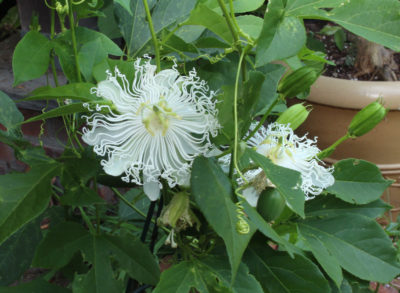
Flowers would be enough, but there’s more. A few weeks later, those flowers morph into egg-shaped fruits: tropical passionfruits this far north.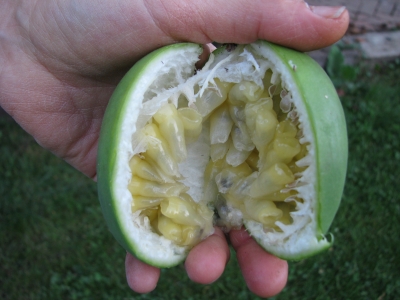
In southeastern U.S., maypop, with its spreading root system, is considered a weed. This far north, maypop will enjoy the extra heat of the microclimate at the south face of the woodshed. The woodshed itself will contain the plant in its travel northward. The lawnmower will contain the plant in is travel southward. Let it spread all it wants east and west along the base of the shed.
Morning Glory & Kin for Quicker Effect
In spring I planted a maypop plant at the foot of four of the woodshed bays. As a perennial, maypop needs time to get established. Because I went to the trouble of hanging a trellis from each of the bays, I wanted something to clothe even this summer.
Enter the Convolvulaceae family, which counts morning glory among its kin. Less know, but also kin and vines with pretty flowers, are cardinal vine and moonflower. I figured that some member of this family could accompany maypop in each planting hole.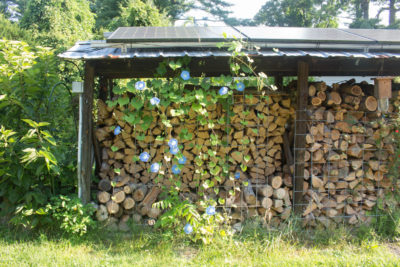
All three Convolvulaceae family members grow vigorously so could provide good coverage for the woodshed. They also integrate well with each other, design-wise. Morning glory wakes up early, its sky-blue flowers opening each morning to foreshadow the blue sky that lies ahead. (The flowers remain furled under overcast skies.) Once the sun rises high in the sky, fire-engine red flowers of cardinal flower take the torch for the remainder of the day. As night falls, moonflowers’ large, white trumpets open and emit their sweet scent.
This year, those annual vines grew so vigorously that they stunted their companion maypops. Next year will be better. Also, a couple of plants of another vine, native and somewhat decorative, have tried to get a foothold in the planting. Poison ivy, you’re not welcome here.
Autumnal Readiness
Morning glories have started lingering later into the mornings, a sign that autumn is approaching. I’m also getting signals — a softness in the air and an occasional chill, a slight chill — of autumn’s approach. Those signals do not have me lingering late in the morning, though.
The imminence of autumn has me scurrying around making sure all is copacetic in the weeks to come and on into next year. Turnips and winter radishes have been thinned. Cabbages, Chinese and European, transplants are growing well, hinting at crocks of kim-chi and sauerkraut to come. Onions have been harvested and woven into ropes for storage, now in the garage, later in the basement.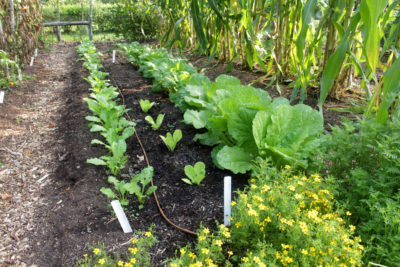
Any cleared vegetable bed is given a thorough weeding and then an icing of an inch depth of compost. That compost will snuff out small weeds attempting to sprout below. Additionally, it will feed soil microbes which will, in turn, feed plants for at least a year. I’ll sow arugula, mustard greens, and “spring” radishes in the bed which I recently cleared of sweet corn, weeded, and composted.
A couple of sites have been prepared for two new trees. “Prepared” is too fancy a word; all I did was pile mulch on the ground at both locations. The mulch will kill existing vegetation and leave soft, moist ground for easy planting in October.
Autumn will be bountiful and next year will be a good year.
UNPERMACULTURE
/0 Comments/in Design, Fruit, Gardening, Pests, Soil, Vegetables/by Lee ReichAccusations, (Mostly) not True
I’ve understandably been accused of being a “permie,” that is, of practicing permaculture.
(In the words of permaculture founder, Bill Mollison, “Permaculture is about designing sustainable human settlements. It is a philosophy and an approach to land use which weaves together microclimate, annual and perennial plants, animals, soils, water management, and human needs into intricately connected, productive communities.” In the words of www.dictionary.com, permaculture is “a system of cultivation intended to maintain permanent agriculture or horticulture by relying on renewable resources and a self-sustaining ecosystem.”)
Walk around my farmden and, yes, you’ll come upon Nanking cherry bushes where forsythia bushes once lined the driveway, an American persimmon tree where a lilac bush once stood, and other edible plants used also for landscaping. In the vegetable garden, I preserve soil integrity by never tilling it, and, in the south field, blackcurrant bushes make use of the space beneath pawpaw trees. There’s the requisite mushroom yard of shiitake-inoculated logs, free-range poultry, solar panels, a rain barrel . . .

Pawpaws interplanted with blackcurrants, and a row of hardy kiwis
But no! I am not a permie. My vegetables grow in beds in parallel, straight rows (rather than keyhole plantings) and, despite that commingling of blackcurrants and pawpaws, most trees, shrubs, and vines here keep to themselves. Permaculture plantings of, say, hazelnuts in tall grass and rubbing elbows with elderberries, seaberries, apples, pears, and other edibles become, over time, an unproductive management nightmare with some plants drowning out others, productivity declining due to shade, and diseases increasing from tangled stems creating dank conditions. The paltry output of such planting are best left for wildlife, who can afford to spend all day foraging for a few tidbits of food.
My hazelnuts are grown in a mown strip that, for easy gathering, is sheared low as nuts ripen.
Low maintenance is a goal touted by permaculturalists; understandably so. But taken to the extreme, low maintenance means not giving the grape vine the pruning it needs to be a healthy vine yielding the most flavorful berries that are easy to harvest. (One book suggests, rather than troubling with a trellis, growing grape vines up trees; the vines do so in the wild, but such fruit, in partial shade and not easily accessible, can never be high quality.)
Much of permaculture seems to me to be not only unrealistic, but also no fun. I enjoy caring for my plants, reaping the gustatory and other rewards for a job well done. I like the challenge of researching some pest or nutritional problem and finding a solution. I like watching how plants respond to my ministrations, whether I’m wielding pruning shears, a pitchfork piled high with compost, or my winged weeder hoe.
Agriculture is about balancing Nature’s designs and human will. Too much of the latter is a losing battle. Too much of the former leaves nothing worth harvesting.
Big Bantam, an Oymoron
My planting of sweet corn is very un-permaculture. It’s high-culture: 6 seeds per hill dropped into compost-enriched ground maintained weed-free, timely watering with drip irrigation, hills thinned to 3 stalks per hill, even stakes to keep the stalks standing soldier straight. I mentioned, last week, how my Golden Bantam variety of sweet corn isn’t bantam at all. The stalks soar over 10 feet high.
Was it because of my green thumb? No. I now know that it is genetics.
This year I made four plantings of Golden Bantam. The two later plantings are, in fact, bantam-size. Looking over my seed orders, I see that I had planted Golden Bantam Corn, Original 8-row Golden Bantam Corn, and Improved Golden Bantam Corn.
Golden Bantam is an open-pollinated variety. As with any open-pollinated variety, various strains might arise, strains which might differ in some ways from the original. With any good variety, the hope is that progeny are monitored to eliminate any off-type varieties — or to look for something that might be better than the original.

Golden Bantams compared
So the name Golden Bantam could be attached to the original Golden Bantam, from 1902, or any strain, which could also have “Improved,” “Original,” etc. attached its name. (Golden Bantam was also developed into a hybrid, Golden Cross Bantam, which, like other hybrids, would be genetically more consistent and ripen in a shorter window of time.)
On the theory that bigger is better, “Improved” was tacked onto name of the strain of my early plantings. The original Golden Bantam was 8-row; Improved Golden Bantam is 10 to 14 row. I should have read the catalog more closely because Improved Golden Bantam casts too much shade, ripens too late for my intensively planted vegetables, and yields less, with but a single ear per stalk. The original also has better flavor, to me.
Permaculture, but not by Me
Walking down the main path of my vegetable garden yesterday, you’d come upon a very permaculturalesque planting — in the path. The path was overrun with purslane, which I didn’t even have to plant. Purslane is a tasty, very nutritious vegetable enjoyed raw or cooked. But not by me.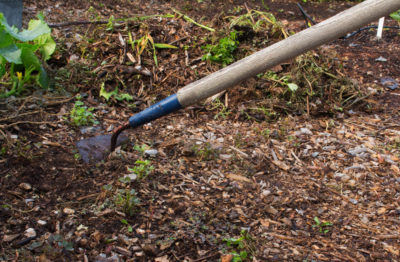
I grabbed my winged weeder and hoed the purslane loose from the soil. As a succulent, purslane can continue to grow — and seed! — even with its roots flailing in the air. So after hoeing, I scooped the plants up to feed to the compost file.
PROXIMAL THOUGHTS, PROXIMAL ACTION
/4 Comments/in Design, Gardening, Planning, Tools, Vegetables/by Lee ReichEasy Access Water
I am reminded today of the importance — in a home garden — of proximity. Proximity of the garden to a door or, even better, a kitchen door. Proximity of the compost pile to a door, to the garden, and, if bulky materials such as manure or wood chips are hauled in, to a driveway. And, the spur for today’s rambling, proximity of the garden to water spigots.
The saying that “April showers bring May flowers” notwithstanding, supplemental water is usually critical in my garden in April. Just a few days of sunny, balmy weather is enough to dry out the surface of the ground, just beneath which lie in waiting, for moisture, my newly sown seeds. Or recent transplants, whose roots have yet to venture out and down into the ground.
Once roots from sprouting seeds and transplants start growing in earnest, they’ll encounter plenty of residual moisture still sitting in the soil from winter’s rain and snow. Until then, I either have to carry watering cans (two cans at two gallons each) back and forth from the frost-free spigot against my house to the garden, or haul around hoses. The cans are top of the line Haw’s galvanized with good balance; even so, hauling water can get tedious, and the tendency to skimp a little on watering is unavoidable.
Fifteen years ago I installed a frost-free outdoor hydrant near my secondary vegetable garden. What a luxury! Problem is that to get water to the main vegetable garden I have to unwind a hose and thread it through the garden gate. And then, if temperatures drop below freezing at night, common in April, nothing can be done till ice in the hose has defrosted. Again, watering is too often inadequate because I’m avoiding all this hassle.
(Hot temperatures, dry weather, and plants feverishly sucking moisture out of the soil present no problem during most of the growing season — now, for instance. A few times each day, an inexpensive timer automatically opens a valve to let water flow through tubes to each vegetable bed and then out specially designed emitters to drip water into the ground at about the rate at which plants are drinking it up. But this automated, drip irrigation system can be damaged if put into service when temperatures drop below freezing.)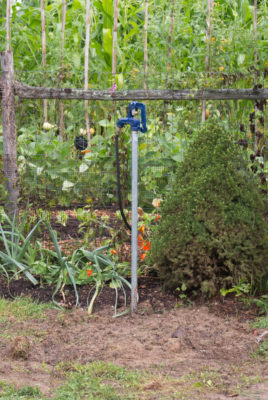
So today I’m digging tenches and holes for two new, frost-free hydrants to bring the source of water right next to the main vegetable garden and to my compost bins. In the future, I’ll have no excuse to skimp on watering.
Free “Fertilizer”
Too may gardeners shove their gardens in a far corner of their property, as if the garden was an eyesore. (Which it often is.) I suggest locating the garden as close to the house as possible, given constraints of sunlight; six or more hours of summer sun, daily, is ideal. And make it ornamental, with fencing, a nice gate, and shrubs and flowers around and in it. Keeping it weeded also helps, as far as appearance and productivity.
There’s an old saying that “The best fertilizer is the gardener’s shadow.” Make it so that shadow conveniently falls on not only the plants but also spigots and compost piles.
Celeriac, What’s Up?
Insufficient water in April could not be blamed for the poor showing of my celeriac plants. They weren’t even in the ground until early May, after the drip irrigation was up and running.
Celeriac is a nice addition to the variety of root crops that can be left in the garden until late into fall and then stored for the winter under cool, moist conditions. The flavor, which comes from the swollen root (actually a hypocotyl, which is the portion of the plant above the roots and below the stem), is akin to celery, but smoother. It’s a botanical variety of celery.
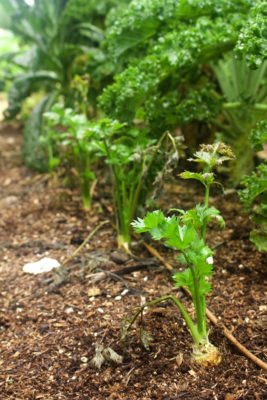
Celeriac in old home
Last year, the first time in years that I grew celeriac, plants were stunted with nothing to harvest. Last year, I set the plants in a narrow bed on the west edge of the garden next to a full bed of tall corn. I blamed my failure on shade.
This year celeriac got a sunnier spot. Still, the plants are puny. Some of the plants share the bed with kale which has spread its large leaves to create more shade than expected. Celeriac, according to reputable sources, allegedly tolerates a bit of shade.

Celeriac in new home
My plan is to slide a trowel into the ground beneath some of the puniest plants, lift the plants out of the soil, and plop them into more spacious, sunny environs.
Next year I’ll pay even closer attention to celeriac and expect a better harvest. (Then again, this season’s plants may be gathering energy, readying themselves to swell their hypocotyls as autumn draws near.) All part of next year’s even better vegetable garden, to which my new frost-free hydrant will be a serious contributor.

